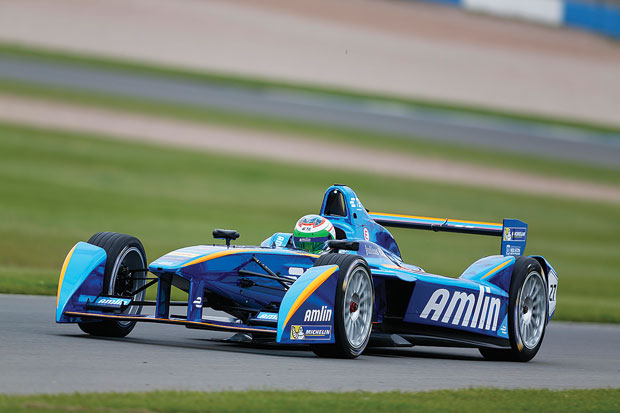Formula E cars emerge from their team garages with a suddenness that seems incongruous. Even on their way to practice laps, the drivers turn their cars sharply from the garages and accelerate in apparent anger along the asphalt leading to the circuit. When the second season of the electric formula-racing series begins in late October, in Beijing, they may be able to drive with even more aggression: Unlike during the competition’s first season, each team can now choose its own power train and will also employ a host of smaller technology tricks learned from last year’s racing.
The first season was dominated by close jostling among the drivers: It began in Beijing with a crash that upset the two front-runners. Over the course of the next 10 races, no single team or driver took a definitive lead, and the championship was up in the air until the final lap of the last race. That may have been in part because the 10 teams were all using the same hardware. “This is the last year of such close racing,” predicts Deogracias Vidal, a mechanic for NextEV TCR, the team whose driver, Nelson Piquet Jr., won the first season’s individual championship. “Next year’s motors will make a big difference,” Vidal says.
In addition to the motors, the other big changes will be in the inverters and the gearboxes, but the teams have let only limited details emerge. McLaren built the power trains in the first series, but eight manufacturers have stepped into the fray for the second season of Formula E. McLaren will offer an upgraded version of its motor, dropping the number of forward gears from five to four. The Abt Schaeffler Audi team will use three gears, the e.dams-Renault team will use two gears, and NextEV TCR and DS Virgin Racing are using direct-drive systems, which are effectively just one gear—although Virgin will use a twin motor.
Fewer gears means less time spent switching among them: In one race last year, there were 23 gear changes per lap on average, adding up to more than a second of lost power and charging. But less shifting comes with an efficiency cost, as the motor will spend more time outside its best performing range.
The Amlin Andretti team is replacing its off-the-shelf inverter with a custom one. “People who are buying qualified, highly reliable things may not get to enjoy the latest improvements in what’s on the market today,” says Nicolaus Radford, chief technology officer of NASA parts supplier Houston Mechatronics, the company that built Andretti’s new motor and inverter. But custom gear can come with more integration challenges, as Andretti experienced when it missed days of track testing in August and wound up changing back to its old motor.
In addition to hardware changes, there is room for applying lessons from the first season to racing strategies, says Peter McCool, technical director of Team Aguri. Teams now have a complete set of performance data from 10 racecourses, at least eight of which will feature in the second season. McCool’s team has written its own software to guide battery management, he says, and it should be able to get better performance next year. Battery management is particularly important because rules limit both maximum power output (150 kilowatts last season) and total energy use (28 kilowatt-hours last season). Drivers can recharge the battery a little by coasting and braking, but “energy in and energy out doesn’t come for free,” says Gérry Hughes, chief engineer of Team Aguri. For example, charging and discharging raises the battery’s temperature, altering its performance.
Formula E’s unique restrictions have forced teams with more experience on the gas-guzzling Formula One races and endurance races such as Le Mans to be more creative. Hughes calls it a selling point for engineers like him, who have worked on more conventional motor-sport series. Formula E “allows me to sort of broaden my horizons in new technology,” Hughes says. For one thing, batteries are so foreign to most motor-sport engineers that they have had to seek outside expertise. “Anything you can learn over and above your competition can stand you in good stead,” he says.
Throughout the second season, the battery maker Williams Advanced Engineering will be in the best position to learn about battery use, since it has access to all the data and it supplies the battery’s controller. The 10 teams generated about 60,000 kilometers’ worth of racing data over the first season’s 11 races, says Okan Tur, Williams’s chief technical specialist for the batteries. “We’ll see how we can use that data in the best way and to guide us in our future battery designs,” he says. In the second season, teams will reuse the first season’s batteries’ outer structure and electronics, but Williams will swap in new cells and thermal control structures. “We had some cell-level improvements in the past year,” Tur says. “We’re quite optimistic that it will result in improved performance with no design changes.”
Formula E’s founder, Alejandro Agag, has made a lot of noise about how the technology tested in the series will someday reach everyday hybrids and electric cars. But that may not be the most lucrative place to market high-performance electric motors and batteries. Hughes says, with more mystery than specificity, that one of Team Aguri’s technology partners is already “applying these types of tech to other forms of transport that don’t have wheels.”
